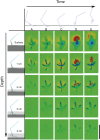The birth of a dinosaur footprint: subsurface 3D motion reconstruction and discrete element simulation reveal track ontogeny
- PMID: 25489092
- PMCID: PMC4280635
- DOI: 10.1073/pnas.1416252111
The birth of a dinosaur footprint: subsurface 3D motion reconstruction and discrete element simulation reveal track ontogeny
Abstract
Locomotion over deformable substrates is a common occurrence in nature. Footprints represent sedimentary distortions that provide anatomical, functional, and behavioral insights into trackmaker biology. The interpretation of such evidence can be challenging, however, particularly for fossil tracks recovered at bedding planes below the originally exposed surface. Even in living animals, the complex dynamics that give rise to footprint morphology are obscured by both foot and sediment opacity, which conceals animal-substrate and substrate-substrate interactions. We used X-ray reconstruction of moving morphology (XROMM) to image and animate the hind limb skeleton of a chicken-like bird traversing a dry, granular material. Foot movement differed significantly from walking on solid ground; the longest toe penetrated to a depth of ∼5 cm, reaching an angle of 30° below horizontal before slipping backward on withdrawal. The 3D kinematic data were integrated into a validated substrate simulation using the discrete element method (DEM) to create a quantitative model of limb-induced substrate deformation. Simulation revealed that despite sediment collapse yielding poor quality tracks at the air-substrate interface, subsurface displacements maintain a high level of organization owing to grain-grain support. Splitting the substrate volume along "virtual bedding planes" exposed prints that more closely resembled the foot and could easily be mistaken for shallow tracks. DEM data elucidate how highly localized deformations associated with foot entry and exit generate specific features in the final tracks, a temporal sequence that we term "track ontogeny." This combination of methodologies fosters a synthesis between the surface/layer-based perspective prevalent in paleontology and the particle/volume-based perspective essential for a mechanistic understanding of sediment redistribution during track formation.
Keywords: XROMM; dinosaur; discrete element method; footprint; locomotion.
Conflict of interest statement
The authors declare no conflict of interest.
Figures





References
-
- Li C, Zhang T, Goldman DI. A terradynamics of legged locomotion on granular media. Science. 2013;339(6126):1408–1412. - PubMed
-
- Mazouchova N, Umbanhowar PB, Goldman DI. Flipper-driven terrestrial locomotion of a sea turtle-inspired robot. Bioinspir Biomim. 2013;8(2):026007. - PubMed
-
- Stephens PA, Zaumyslova OY, Miquelle DG, Myslenkov AI, Hayward GD. Estimating population density from indirect signs: Track counts and the Formozov–Malyshev–Pereleshin formula. Anim Conserv. 2006;9(3):339–348.
-
- Mayle BA, Putman RJ, Wyllie I. The use of trackway counts to establish an index of deer presence. Mammal Rev. 2000;30(3-4):233–237.
Publication types
MeSH terms
LinkOut - more resources
Full Text Sources
Other Literature Sources

